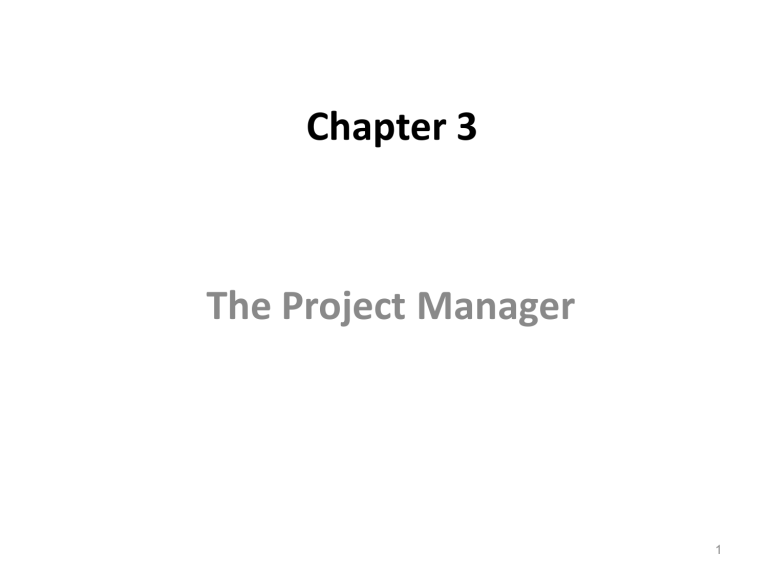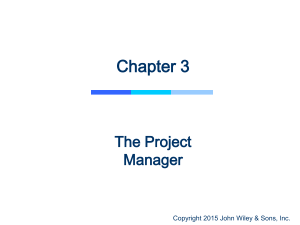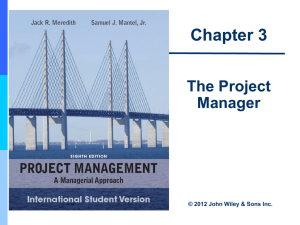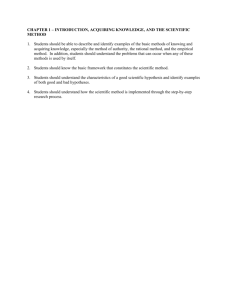
Chapter 3 The Project Manager 1 The Project Manager • The project manager can be chosen and installed as soon as the project is selected for funding – This simplifies several start up activities • The project manager can be chosen later – This makes things difficult • Senior management briefs the project manager • Project manager begins with a budget and schedule 3-2 Functional Management • Department heads are usually functional specialists • They have the required technical skills to evaluate all members of their organization • Functional managers: – Decide who performs each task – Decide how the task is performed – Exercise a great deal of control over every aspect of the work that gets performed 3-3 within their area Project Management (Slide 1 of 2) 3-4 Project Management (Slide 2 of 2) • Project managers are usually generalists • It would be very unusual for a project manager to have all the technical skills that are used on their projects • Project managers: – Rarely decide who performs each task – Lack the technical skills to evaluate much of the work performed on a particular project – Exercise control very little over most aspects 3-5 of the work that gets performed on the Comparing Functional & Project Managers Functional Managers Project Managers need technical skills need negotiation skills should be more skilled at analysis should be more skilled at synthesis use the analytic approach use systems approach responsible for a small area responsible for the big picture act as managers act as facilitators responsible for a small area responsible for the big picture act as direct, technical supervisors act as facilitators and generalists 3-6 • • • Three Major Questions Facing Project Managers What needs to be done? When must it be done? How are the resources required to do the job to be obtained? 3-7 Project Manager Responsibilities • • • The parent organization The project and the client The project team 3-8 The Parent Organization • Proper usage of resources • Timely and accurate reports • Keep project sponsor informed 3-9 The Project and the Client • Preserve the integrity of the project – This may be difficult with all sides wanting changes • Keep the client informed of major changes 3-10 The Project Team • Very few people will work for the project manager • The “team” will disband at the end of the project • The project manager must look out for everyone’s future – This is in the best interest of the project, otherwise as the project winds down, everyone will be looking after themselves 3-11 Project Management Career Paths • Might work on several projects simultaneously • Small short-term projects train new project managers • Start on small projects and work up to large projects • Experience as a project manager is often seen as a desirable step on the corporate ladder 3-12 Sample Career Path • Trainee: – a six-month position to learn about project management • Cost Analysis/Schedule Engineer: – a 6–18 month team position reporting to a project manager • Site Manager: – a 6–12 month position responsible for a large site and reporting to a program manager • Small Project Manager: – sole responsibility for a $1M to $3M revenue project • Project Manager: 3-13 Special Demands on the Project Manager 1. 2. 3. 4. 5. 6. 7. 3-14 Acquiring adequate resources Acquiring and motivating personnel Dealing with obstacles Making project goal trade-offs Maintaining a balanced outlook Breadth of communication Negotiation 1. Acquiring Adequate Resources • • • • Project budgets are usually inadequate Resource trade-offs must be considered Crises occur that require special resources Availability of resources is seen as a “win-lose” proposition 3-15 2. Acquiring and Motivating Personnel (Slide 1 of 2) • Most project workers are borrowed from functional managers • The project manager negotiates for the desired worker but – the project manager wants the best qualified individual – the functional manager decides who to assign 3-16 Acquiring and Motivating Personnel (Slide 2 of 2) • The functional manager also decides: – the skill level to assign – the pay and promotion of the worker • Worker will most likely return to the functional manager once the project is finished • Once workers are assigned to a project, the project manager must motivate them – The project manager has little or no control over pay and promotion 3-17 Most Important Characteristics for Team Members • • • • • High-quality technical skills Political, and general, sensitivity Strong problem orientation Strong goal orientation High self-esteem 3-18 Tuckman Ladder • Teams progress through four development phases: 1. Forming 2. Storming 3. Norming 4. Performing 5. Adjourning has been suggested also 3-19 Nine Key Team Roles by Raymond Meredith Belbin 20 What is Belbin / Team roles? • Belbin have identified nine different behavior types that individuals show in teamwork. • most people have two or three Team Roles that they are most comfortable with • a few other roles they can manage to cover if they need to • and the rest that they prefer not to adopt at all. 21 Belbin team roles 22 Belbin team roles 23 A. Action/ Action oriented 24 1. SHAPER (SH) Individual Characteristics Demanding Dynamic Firm and impatient Contribution to the Team Pushing others into action in order to obtain a result Often quick-tempered and easily frustrated 25 2. IMPLEMENTER (IMP) Individual Characteristics Disciplined Efficient Reliable Contribution to the Team Practical thinker who turns theoretical ideas into workable solutions Conservative 26 3. COMPLETER FINISHER (CF) Individual Characteristics Contribution to the Team Conscientious The team’s detail person; Anxious Attention to detail Searches out errors and omissions Analytical and meticulous approach Meets deadline Knows if team is on track Ensures quality and timeliness 27 B. Social/ People Oriented 28 1. COORDINATOR (CO) Individual Characteristics Mature Confident Contribution to the Team Brings together others’ inputs Concerned with fairness Clarifies goals and equity among team Allocates responsibilities members Leads through Delegates well empowerment Good chairperson Promotes team contribution 29 2.TEAMWORKER (TW) Individual Characteristics Cooperative and supportive Diplomatic Sensitive to others Good listener Help others Contribution to the Team Looks after interpersonal relationship between team members Resolves conflicts Ensures team cohesion 30 3. RESOURCE INVESTIGATOR (RI) Individual Characteristics Contribution to the Team Excellent communicator Develops outside contacts Recognises opportunities Explores opportunities Extrovert Negotiates Enthusiastic Shares external information 31 C. Thinking/ Thought oriented 32 1. PLANT (PL) Individual Characteristics Creative Imaginative Unorthodox Contribution to the Team Provides creative thinking Solves difficult problems Innovation Generates new ideas 33 2. MONITOR EVALUATOR (ME) Individual Characteristics Discerning Strategic Judges accurately Sees all options Contribution to the Team Provides critical inputs, a careful and objective approach Offers options Checks progress Helps team avoid mistakes 34 in the future 3. SPECIALIST (SP) Individual Characteristics Contribution to the Team Has rare and expert skills or knowledge Provides team with specific, technical inputs Dedicated and professional Keeps up to date Single-minded Aware of new developments Accurate information 35 Succes 36 • The effectiveness of a team will depend on the extent to which members correctly recognize and adjust themselves to the relative strengths within the team. 37 Balance is key! • Belbin found that a team with no Plant struggled to come up with the initial spark of an idea with which to push forward. • However, once too many Plants were in the team, bad ideas concealed good ones • with no Shaper, the team ambled along without drive and direction, missing deadlines. • With too many Shapers, in-fighting began 38 3. Dealing with Obstacles (Slide 1 of 2) • Every project is unique • The project manager should be ready to face a series of crises • A big problem is “scope creep” • Good project managers are fire preventers hopefully, but also fire fighters 3-39 Dealing with Obstacles (Slide 2 of 2) • • Early problems are associated with resources Later problems are associated with: – Last-minute schedule and technical changes – The happenings to a team when the project is completed 3-40 4. Making Project Goal Trade-Offs • Project managers must make trade-offs between the project goals of: – Cost – Time – Scope – Ancillary goals • Multiple projects • Project goals and organizational goals • Project, firm, career 3-41 Relative Importance of Project Objectives 3-42 The Project Life Cycle Stages 1. Formation 2. Build-up 3. Main Program 4. Phase-out ICM 1. 2. 3. 4. 5. Initiation Planning Execution Monitor & Control Closing PMI 43 5. Maintaining a Balanced Outlook • Hard to tell where a project is headed • Outlook can change over the life of a project • Technical problems cause waves of pessimism and optimism • Mood swings can hurt performance • Maintaining a positive outlook is a delicate job 3-44 6. Breadth of Communication • Most of a project manager’s time is spent communicating • In order to properly communicate, the PM must deal with or understand: – why the project exists – that some projects fail – that support of the top management is needed – a strong information network is needed 3-45 7. Negotiations • • • • • • Acquiring adequate resources Motivating personnel Dealing with obstacles Making project goal trade-offs Handing failure Maintaining communication 3-46 Most Popular Attributes, Skills, and Qualities When Selecting PMs • • • • • • • • Strong technical background Hard-nosed manager Mature Currently available On good terms with senior executives Someone who can keep project team happy Worked in several departments Can walk on (or part) the waters 3-47 Attributes of Effective Project Managers • • • • Credibility Sensitivity Leadership, ethics, and management style Ability to handle stress • They must also have the drive to complete the task! 3-48 1. Credibility • • Technical credibility Administrative credibility 3-49 2. Sensitivity • Political sensitivity • Interpersonal sensitivity • Technically sensitivity 3-50 Leadership, Ethics, and Management Style • Leadership – “a process of social influence, which maximizes the efforts of others, towards the achievement of a goal” • Strong sense of ethics • A management style that fits the project 3-51 Leadership Research • Conducted by PMI • Six skills identified for a project manager to become a leader: – 29% - communication – 26% - people – 16% - strategic – 12% - requirements gathering – 12% - leadership – 5% - time management 3-52 Leadership Competencies 3-53 Common Ethical Missteps in Business • • • • • “wired” bids and contracts “buy-in” kickbacks “covering” for team members taking “shortcuts” (to meet deadline or budget) • using marginal materials • compromising on safety • violating standards 3-54 Ability to Handle Stress • Signs of excessive stress in workplace – inability to switch-off work issues – disturbed sleep – lack of pleasure in non-work related leisure activities – difficulty concentrating or making decisions – tendency to anger quickly – lack of energy 3-55 Ability to Handle Stress • • • • No consistent procedures Too much to do High need to achieve Organizations in change 3-56




